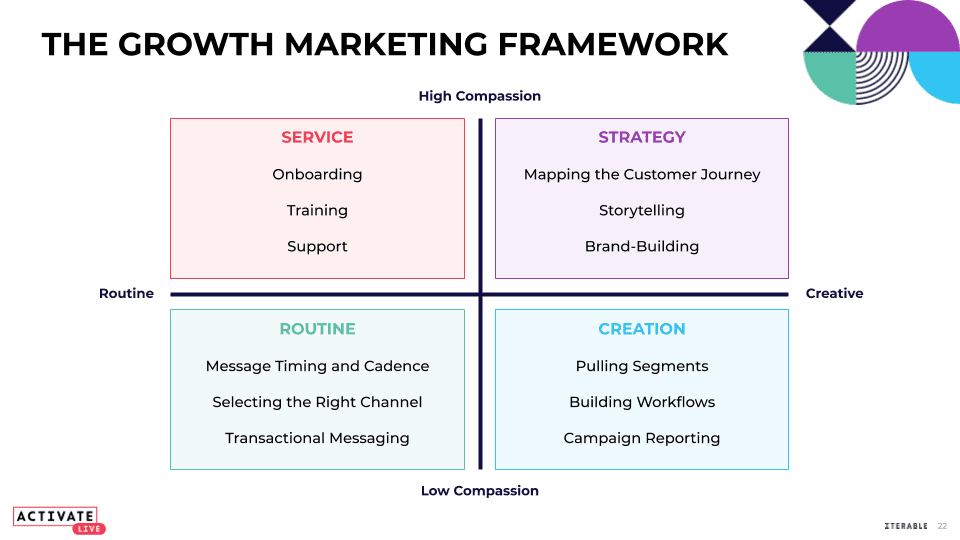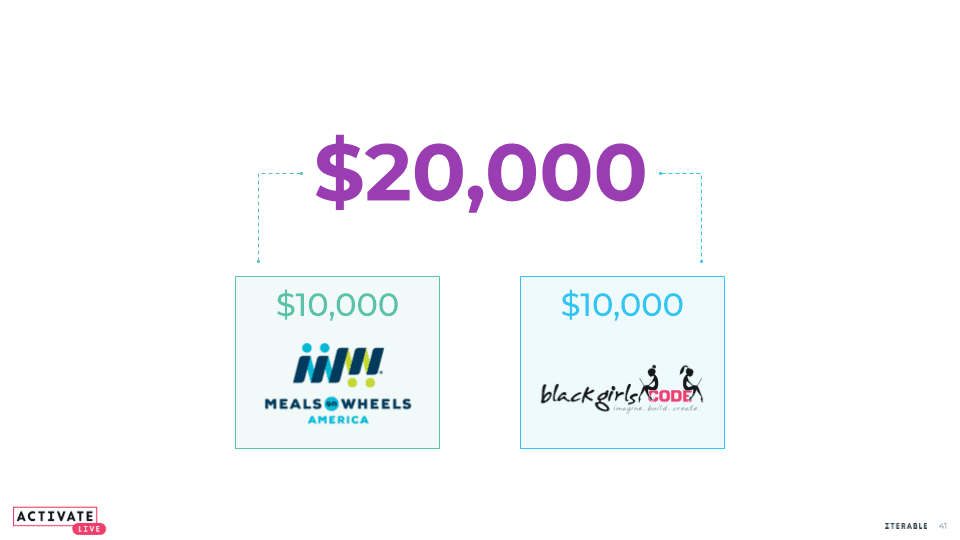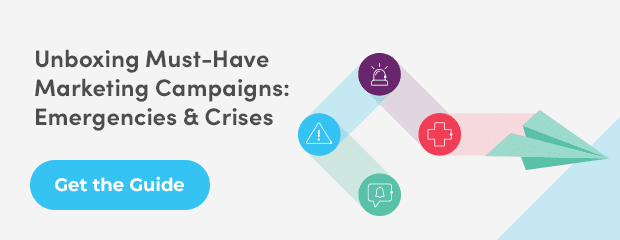On June 24, we kicked off our first all-digital Activate Live conference, where we brought together a community of customers, partners, employees, analysts and branding experts to share best practices for overcoming business challenges, creating innovative campaigns and driving growth.
From user acquisition and retention to CRM, content creation and customer loyalty, there are many sides to growth marketing. So we relied on something we know very well—segmentation—to divide, organize and deliver cutting-edge content straight to your computer screen.
If you missed the day-of—not to worry—because Activate Live is now available to you on-demand.
Wondering where to start? We’ve pulled together 10 moments from the event that made the biggest impact.
1. Opening keynote: Welcome to Activate Live
Iterable Co-Founder and CEO Justin Zhu kicked off the event to share how today’s growth marketing landscape came to be and how recent events have affected the road ahead for marketers and brands.
“What does growth marketing mean? We asked our customers, and it boiled down to a few things: 1. It’s using data to build a personal relationship with customers; 2. It’s how your brand and its messaging makes people feel. 3. It’s being open to change in a world that’s constantly evolving and innovating.”
Inspired by AI expert Kai-Fu Lee’s TED Talk, “How AI can save our humanity,” Justin then introduced the role that artificial intelligence and automation play in growth marketing.
He applied Lee’s teachings to his own Growth Marketing Framework in order to shift marketers’ focus from routine tasks to creative and compassionate brand strategy.


Let AI automate routine tasks to spend more time on growth marketing strategy.
2. Using AI to create human connection
Iterable’s VP of Product Bela Stepanova then put the Growth Marketing Framework that Justin introduced into practice, with a behind-the-scenes look into the latest Iterable innovations, including our newly designed Workflow Studio, Send Time Optimization and Brand Affinity.
Bela closes with a statement on the role of growth marketing technology:
“In the shift from routine to creativity, automation and AI play a huge role. It allows us to better understand our customer base, so we can connect with the right customers at the right time with the right message. At Iterable, we believe that technology is only there to help us—help us unleash creativity, unlock empathy and grow the human connection.”
3. What it takes to build an influential brand
In this keynote address, Jonathan Mildenhall, Co-Founder and CEO of TwentyFirstCenturyBrand, shared his vision to build the most influential brands of (wait for it) the 21st century.
Jonathan and his team work with leaders from companies who want to build “category-defining brands,” which he defines as a brand that has significant meaning, earns a disproportionate share of the market, and has the following four pillars in common:


As discussed, Jonathan would like you to spend some time critiquing your company’s performance on his four-pillar brand model (Source: TwentyFirstCenturyBrand)
After defining what a category-defining brand looks like, he dives into the purpose of an American corporation, which was previously focused on solely maximizing shareholder return.
Now, businesses must deliver value to their customers, invest in growing and developing their employees, deal fairly and ethically with their suppliers, and support the communities within which they work.
So to be a 21st-century brand, you have to have a story, a heart and a baked-in value system. This will ultimately achieve business growth.
4. Understanding the mind of the modern consumer
Our next keynote featured Brendan Witcher, VP and Principal Analyst, Digital Business Strategy at Forrester. Before joining Forrester, Brendan had 25 years of experience working for enterprise organizations in retail and hospitality under his belt, and experience in roles across the board: strategic planning, e-commerce operations, digital marketing, business analytics, customer insights and CRM, to name a few.
So you could say he’s a lifelong expert in consumer behavior and technology trends, which is why he was well-prepared to pursue a key question: What drives digitally-savvy consumers to choose the companies they do business with?
Here’s what we learned: Today’s consumers are less drawn to “household names,” products and brands with historical clout. Instead, they pursue companies that deliver value and relevance. Not through commercials and ads, but through an incredible customer experience.
Brendan’s advice: If you want to win over consumers, invest in individualization, or you’ll get left behind.
5. How to market your brand during a crisis
What does Sophia Le, now email manager at Modulus 7, say about marketing in an emergency?
Here’s what she has learned after nine years of studying disaster-policy research and leading crisis communications for the city of Bellevue, Washington.
- Change your mindset: According to Steven Fink, a crisis is “a dynamic state of affairs with equal parts danger and opportunity.” While a crisis may negatively affect your bottom line, it can also become an opportunity for your brand by practicing empathy and adapting your operations.
- A Single Overriding Communications Objective (SOCO) is critical: It really comes down to simplification. During a crisis, your customers or constituents really need to focus on one thing. They’re likely in a fight-or-flight state, which makes it even more difficult to communicate to them. So before you send a crisis message, ask yourself these five questions.
- Turn to the experts: Governments and nonprofits aren’t exactly known for creative or innovative messaging. But what do they get right? Cross-channel communication. You wouldn’t email someone an emergency alert, so meet customers where they are with SMS, social media and other real-time mediums.
Get even more advice on how to market during a crisis in Iterable’s latest Unboxing Guide to Must-Have Marketing Campaigns, written by Sophia herself and debuted during her session.
6. “Objects in mirror may appear sexier after cleaning”
Alex Reed, Co-Founder and CMO of Truman’s, spent ten years at a ceiling fan company before he made the switch to cleaning products. We asked if he was drawn to boring categories:
“The answer is yes, because I don’t believe there are such things as boring categories. I think there are only boring brands.”
What a way to kick off a presentation!
Alex’s opening remarks focused on key tips for growing your business and developing your brand, but he reminded us of our number-one objective: talking to customers where they are.
Here are three tips he said to keep in mind:
- Simplification. What is perceived as boring might really just be cluttered. Take the clutter out of your product, out of your messaging and out of your brand.
- Go left. If there’s an opportunity to be contrarian, to be different, it should be your north star.
- Embrace your haters. Every industry is going to have people that are opposed to what you are doing. But look at this opposition as an opportunity to connect with your true advocates.
By sticking to your values, having fun, and engaging with your customers at their level, you’re set up for success.
7. Hey Alexa, how can you help our brand?
Alexa and other voice assistants aren’t just a novelty for marketers. In fact, Davida Gaffney, Email/Web Developer at StorageMart, argues they need to be part of your cross-channel strategy.
Here are three reasons why:
- Voice assistants have the fastest adoption rate of any consumer technology in history: More than 50% of the U.S. population has already adopted a smart speaker, so go where your customers already are
- There’s an opportunity to build brand authority: When Alexa answers a question, it first searches its own database. And then it searches its ‘Skills’, which are developed by brands. When you build your product or service into the user’s voice experience, you become the expert.
- Consumers are unlikely to read emails or texts while they’re driving or cooking, so integrate voice into the cross-channel experience. Reduce friction by adding value to customers when they need it.
Intimidated by voice assistants? Don’t sweat it. Davida accomplished this voice integration using Voiceflow, which she integrated to trigger events within Iterable.
8. Email is relationship delivered
We love it when a session surprises our audience. So when Matthew Smith, Co-Founder of Really Good Emails, took an emotional approach to creating great emails and connecting with customers, we were listening. Closely.
How to take emails from “COVID crappy” to “unicorn good” involves more than A/B testing and data analysis. It takes heart.
And Matthew wants you to start your process by clearing your Mental Inbox by focusing on self-empathy to drive customer connection. His reasoning?
- Empathy for ourselves opens us up to empathy for others: So before you write an email, or design a campaign, ask yourself: How do you feel?
- Understand that you are emotionally complex, and your customers are too: Communicate to them like they have emotional range, or they won’t want to listen to you.
- Practice equanimity and mindfulness: Be present with people, places and things as they are—and yourself as you are—without judgment.
Once you’re set with a clear and clean Mental Inbox, you’re ready to communicate with your customers, observe, listen and iterate.
Matthew ends with some solid advice:
“I don’t believe that email is marketing. Email is relationship delivered. There is an opportunity to actually be in a relationship with your customers.”
We think so too.
9. The special announcement at Activate Live
No, it’s not a product launch. The most impactful moment for us at Activate Live this year was about giving back to our community. We’re living in a period of immense suffering for many people, whether they and their loved ones are affected by COVID-19 or by systemic racism.
It was important that we use our platform to make a difference in the world, so Iterable CEO Justin Zhu closed his keynote address with this surprise announcement:
“To recognize all the suffering happening in the world today—the pandemic and systemic racism—we are supporting two causes that we’re passionate about. We’re donating $10,000 to Meals on Wheels America and $10,000 to Black Girls Code.”


Iterable CEO Justin Zhu announces a $20,000 donation, split between Meals on Wheels America and Black Girls Code, on behalf of Activate Live attendees.
10. Decide for yourself: Which moment made the biggest impact at Activate Live?
We’re all about customer engagement and feedback, so tell us what your favorite moment was at Activate Live. Join the #Activate20 conversation by following Iterable on social media or contact us directly at activate@iterable.com.
If you haven’t had the chance to join the fun, register for our on-demand recordings. Sign up for our blog newsletter as well to receive the latest insights, trends and best practices in the world of growth marketing.
Thank you again to all our customers, sponsors, partners, employees and members of our community for making our first virtual conference a massive success!






























